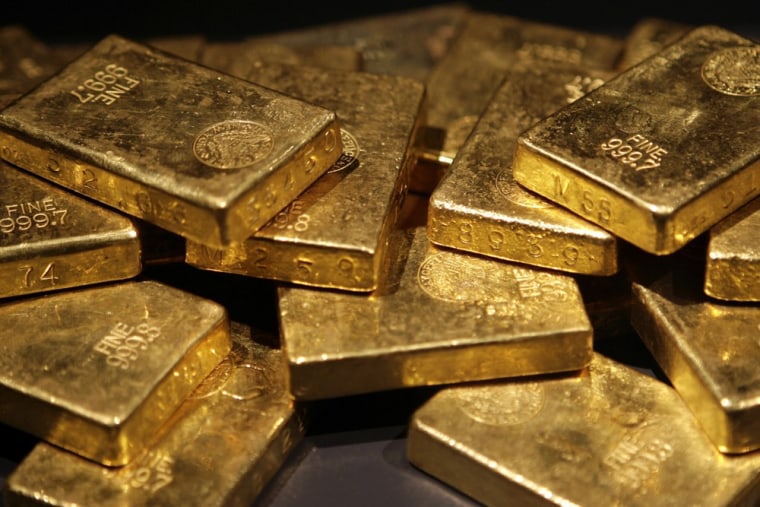
Updated at 10:30 a.m. ET: Tapping a popular idea to restore confidence in the dollar, the Republican Party is expected to call for a commission to look at the idea of returning the U.S. to the gold standard.
To make that happen, they're going to have to find a lot more gold.
The idea, which has gained currency since the Federal Reserve flooded the financial system with money following the Panic of 2008, will be floated as a proposed plank in the party platform, to be voted on this week at the GOP convention in Tampa, Fla.
Proponents of the idea point to the creation of a Federal Gold Commission shortly after Ronald Reagan took office in 1981, when double-digit inflation was crippling the U.S. economy. Today, the fear is that massive government spending and more than $1 trillion in monetary expansion by the Fed will spark a new wave of inflation in the future.
“People believe we need to do something about the Fed; we need to do something about inflation,” said Marsha Blackburn, a Republican congresswoman from Tennessee and GOP platform committee co-chair. “When things you are doing aren't working you start looking at options, just like Reagan did."
The idea of restoring the link between the dollar and gold that was severed 40 years ago got some traction earlier in the presidential campaign from candidate Ron Paul, a Republican congressman from Texas, who continues to support the idea.
"It is horribly unjust to force the American people to do business with a dollar that is continuously debased by the Federal Reserve," he said at a recent hearing on monetary policy.
No one disputes that the swollen national debt poses a threat to the long-term health of the economy. Some Fed policymakers have recently expressed concerns about the possible side effects of another round of financial pump-priming that would further expand the central bank’s balance sheet.
Photoblog: Ron Paul and Tea Party supporters rally before GOP convention
“I do worry that we're facilitating debt buildup in the U.S.,” said James Bullard, president of the Federal Reserve Bank of St. Louis. “This is the wrong time in the global situation to be building up a lot of debt. You’ve just seen the terrible consequences in Europe from doing that, so I do worry about that."
Though the demise of the gold standard played out over decades, President Richard Nixon officially broke the link between gold and the dollar after the 1971 oil crisis sparked a surge in demand for gold redemptions from U.S. trading partners. Since then, the value of the currency has been set by daily fluctuations on a global market where values can change in a fraction of a second.
“Back in the 1950s, and before that, when you were making economic decisions on a quarterly basis you could move slowly,” said Ralph Silva, director at Silva Research. “Today you’ve got to make decisions on a quarter-of-a-second basis.”
Popular support for a return to the gold standard is fueled, in part, by nostalgia for a simpler time.
“If we could turn the clock back maybe 150 years then it’s possible for the U.S. dollar to be linked to gold,” said Moorad Choudhry, treasurer of the corporate banking division of RBS. ”I think it’s absolutely nonsensical. It won’t work. There’s a very good reason (the U.S.) unhooked it in 1971. It’s because their deficit didn’t enable them to maintain (the gold standard) with their supply of gold.“
That problem would be an order of magnitude worse today.
The U.S. holds 8,133 metric tons of gold reserves, according to the World Gold Council, or about 261 million ounces. At current market prices of about $1,667 an ounce, those reserves are worth roughly $435 billion.
That would cover less than 3 percent of the $15.9 trillion in Treasury debt outstanding. In fact all the worlds’ reserves -- estimated at 31,353 tons, or just over a billion ounces -- is not nearly enough to cover the outstanding U.S. debt.
And that’s just the money owed holders of public debt. On top of that $15.9 trillion, the U.S. would have to be willing and ready to exchange gold for the additional $10 trillion supply of money, from paper currency to bank deposits, denominated in dollars.
That was one of the reasons cited by Reagan’s gold commission when it recommended against the idea in March 1982.
“Most of us believe that even if other countries with substantial gold stocks and the major gold-producing countries were to agree with us on a restoration of an international gold standard, the United States -- and the system as a whole -- would confront an as-yet unsolved problem of the vast quantity of dollars worldwide with potential claims to gold convertibility,” the commissioners wrote in their final report.
Below, Rep. Ron Paul, (R-Texas), discusses a return to the gold standard with CNBC.